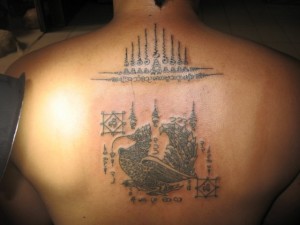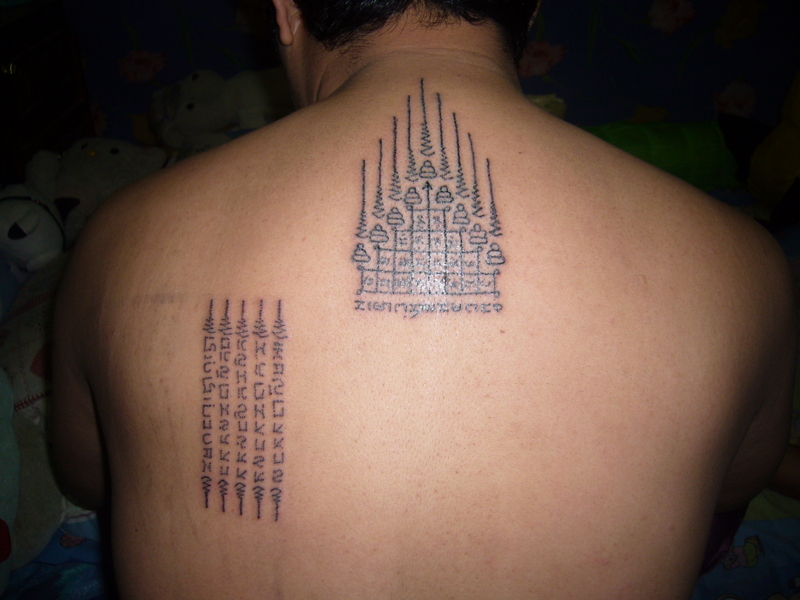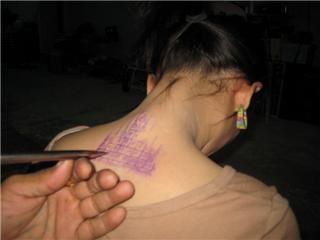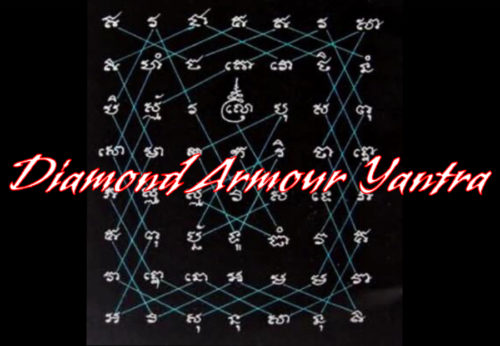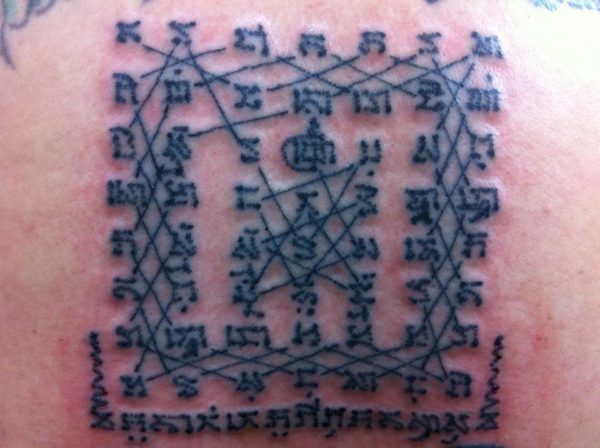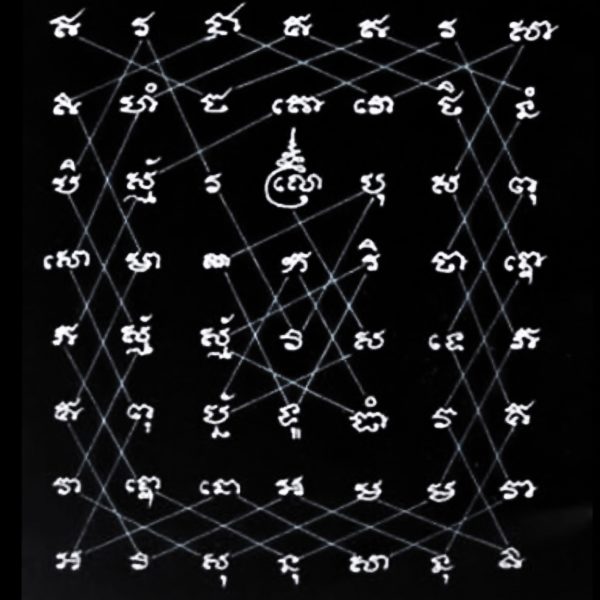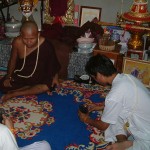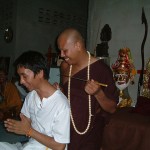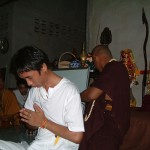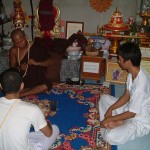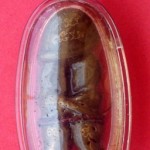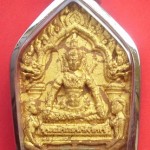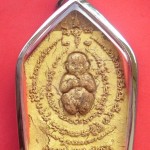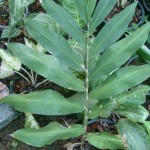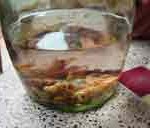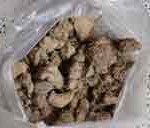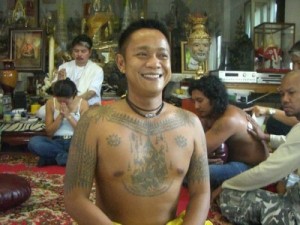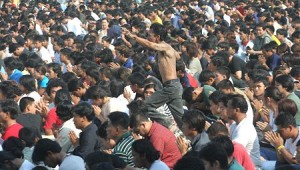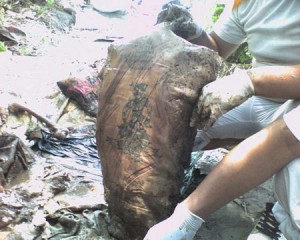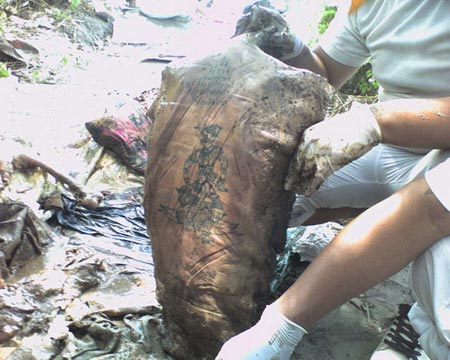Yant Gao Yord (ยันต์เก้ายอด): The Quintessence of Sacred Protection
As an individual deeply immersed in the esoteric traditions of Southeast Asia, particularly the intricate world of Sak Yant, I can confidently assert that the Yant Gao Yord (ยันต์เก้ายอด) holds a singular and preeminent position within the vast pantheon of Thai sacred tattoos. Its ubiquity on the skin of practitioners, from novices to seasoned masters, is undeniable, making it arguably the most frequently inscribed Yant across Thailand’s temples and private samnak.
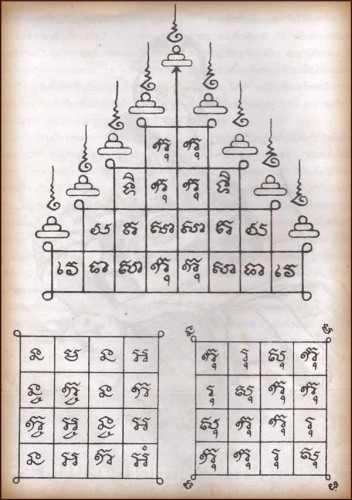
Yant Gao Yord and 2 Pratap Hlang Seals – for sealing the spell – usually added to the shoulder blades beneath the Yant in Sak Yant Thai Temple Tattoos. Otherwise inscribed on the rear face of the Yantra Foil for Takrut amulets
This widespread adoption is not merely a matter of aesthetic preference; it speaks to the profound symbolic resonance, protective efficacy, and foundational significance that the Gao Yord embodies within the spiritual framework of Wicha Sak Yant. In this extensive discourse, I aim to dissect the multifaceted nature of the Yant Gao Yord, exploring its historical trajectory, its intricate design, its esoteric meanings, and the compelling reasons for its status as a foundational Yant Kroo (Master Yant) for countless Kroo Ba Ajarn (revered teachers) in the lineage of this ancient art.
To comprehend the significance of the Yant Gao Yord, one must first appreciate its fundamental structure. The term “Gao Yord” literally translates to “Nine Spires” or “Nine Peaks.”
This numerical and architectural motif is central to its design, which typically features nine distinct representations of the Buddha. These ‘peaks’ are often depicted as conical or pyramidal shapes, each representing a specific aspect of the Buddha’s virtues, a sacred blessing, or an invocation. The precise arrangement can vary slightly between different lineage (samnak) traditions, but the core ‘nine’ element remains constant.
These central nine spires are invariably accompanied by surrounding Aksorn Khom (Khmer script) sacred syllables, known as Kata (mantras or incantations), and sometimes by other protective symbols or geometric patterns. It is this combination of iconographic representation and phonetic power that imbues the Yant Gao Yord with its potent protective qualities.
My own journey into the depths of Sak Yant has afforded me the privilege of studying numerous variations of the Gao Yord, from the minimalist designs favoring raw spiritual power to more elaborate compositions reflecting specific regional styles.
What becomes immediately apparent is that while the fundamental concept of nine spires remains, the nuanced interpretations by different masters highlight the living, evolving nature of this tradition.
Some Ajarn emphasize the Na Yord Gaew (นะยอดแก้ว), the “Jewel Summit” Yant, within each spire, while others focus on specific Buddha Kata (คาถาพระพุทธเจ้า), or invocations of the Buddha’s divine qualities, such as Itipiso, a powerful Buddhist chant encapsulating the Buddha’s ninety-nine virtues.
The spiritual attributes attributed to the Yant Gao Yord are comprehensive and multifaceted. Primarily, it is revered as a general-purpose protective Yant, offering universal blessings and safeguarding against a wide array of dangers.
These include:
Maha Amnaj (มหาอำนาจ): Bestowing great power, authority, and influence. This is particularly relevant for leaders, soldiers, or anyone seeking to command respect and presence.
Maha Metta (มหาเมตตา): Cultivating loving-kindness and compassion, thereby fostering popularity, goodwill, and favorable interactions with others. This aspect brings forth friendliness and benevolence, helping the wearer avoid conflict.
Klaew Klaad (แคล้วคลาด): Providing evasion from danger, accidents, and harm. This protective quality enables the wearer to avoid perilous situations entirely, or to emerge unscathed from them.
Kongkrapan Chadtri (คงกระพันชาตรี): Granting invulnerability against sharp objects and physical harm. While not absolute, it is believed to reduce the severity of injuries and protect against penetrating wounds.
Chok Lap (โชคลาภ): Attracting good fortune, prosperity, and success in endeavors. This aspect is often sought by merchants and those in business.
Serm Duang (เสริมดวง): Enhancing one’s destiny and improving astrological fortune. It is believed to counteract negative planetary influences and bad luck.
Poka Sap (โภคทรัพย์): Drawing in wealth and abundance. This is distinct from Chok Lap in its focus on material accumulation and financial stability.
Gan Phii (กันผี): Protection against malevolent spirits, black magic, and negative energies. This is a crucial aspect in a culture where belief in such forces is pervasive.
It is this broad spectrum of blessings that makes the Yant Gao Yord an ideal introductory Sak Yant for many, serving as a foundational layer of spiritual protection upon which further, more specialized Yant can be built. In many samnak, it is the first Yant a practitioner receives, establishing a baseline of merit and protection.
Delving into the “construction” of the Yant itself, beyond the visual elements, involves a profound understanding of Pali (บาลี) and Khmer (ขอม) liturgical languages, which form the bedrock of the Kata. The Kata (คาถา) are not merely arbitrary syllables; they are meticulously selected and arranged invocations derived from ancient Buddhist and animist texts. Each syllable, when properly chanted during the tattooing ceremony (Sak Yant Pluk Sek), is believed to resonate with specific cosmic energies and spiritual entities, activating the Yant’s inherent power. For instance, the Na (นะ) symbol, often found within or near the spires, is a potent abbreviation of Namo Buddhaya (นะโมพุทธายะ) – “Homage to the Buddha” – a foundational reverence. The specific Kata associated with Gao Yord often invoke the Buddha Koon (พุทธคุณ), the virtues of the Buddha, creating a spiritual shield.
The reasons for the Yant Gao Yord’s status as a Yant Kroo (ยันต์ครู) – a master Yant or fundamental Yant – for so many Kroo Ba Ajarn are multifold and deeply rooted in the practicalities and philosophies of Sak Yant. Firstly, its comprehensive protective qualities make it an indispensable foundation. An Ajarn often ensures that their students or followers possess this basic layer of spiritual armor before moving on to more specialized Yant that might address specific needs or aspirations. It’s akin to teaching the fundamentals of a martial art before introducing advanced techniques; the Gao Yord provides the essential groundwork.
Secondly, the Yant Gao Yord embodies the core tenets of Buddhist teachings that permeate Sak Yant. The nine spires are frequently associated with the Nine Supreme Blessings of the Buddha (นพเคราะห์), or the nine aspects of the Buddhist Dharma that lead to enlightenment. This strong connection to Buddhist principles makes it an ideal Yant for Ajarn who wish to impart not just magical protection but also spiritual guidance. By receiving the Gao Yord, the practitioner is not merely acquiring a tattoo; they are being initiated into a spiritual path that emphasizes mindfulness, compassion, and the cultivation of good karma.
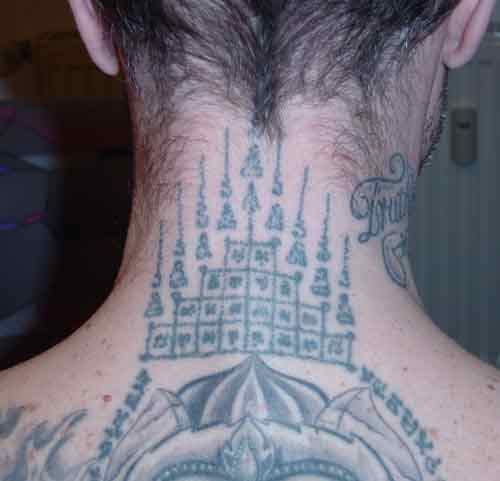
Sak Yant Gao Yord by Luang Pi Pant – this was my (Ajarn Spencer) first Sak Yant tattoo, which is traditional and according to the Dtamra Sak Yant, for this is the Yant Kroo (master Guru yantra) of Luang Por Phern, and should indeed be the first tattoo you receive before any other Sak Yant.
Furthermore, the simplicity and versatility of the Gao Yord’s design allow for its adaptation across various body parts and its integration with other Yant. While it is commonly found on the back, particularly near the nape of the neck as a primary protective barrier, its compact nature allows for placement on arms or chest as well. This adaptability makes it a practical choice for a “first” Yant, or for masters to use as a central protective element in a larger composition of tattoos.
The historical lineage of the Yant Gao Yord is somewhat difficult to trace definitively, as many ancient Yant designs were passed down orally and through master-disciple relationships, with specific details often remaining within the confines of a particular samnak. However, it is widely believed that the core principles of the Gao Yord, incorporating Buddhist iconography and Khom Kata, have roots extending back centuries, possibly evolving from ancient Khmer and Mon animistic beliefs that predate the widespread adoption of Theravada Buddhism in the region. The integration of Buddhist philosophy provided a new, potent framework for these existing spiritual technologies, elevating them to a higher echelon of sanctity. The presence of Khmer script (Aksorn Khom) in virtually all traditional Sak Yant, including the Gao Yord, is a clear indicator of the deep historical and cultural exchange between the Khmer Empire and various kingdoms in what is now Thailand.
In my experience, observing masters like the late Luang Por Pern (หลวงพ่อเปิ่น) of Wat Bang Pra, who himself was deeply associated with the Gao Yord, underscores its enduring power. His renditions of the Gao Yord were imbued with immense spiritual energy, drawing countless devotees seeking its protective embrace. Modern Ajarn continue this legacy, each adding their subtle interpretation while respecting the core principles that define this iconic Yant. The meticulous process of Pluk Sek (ปลุกเสก) – the ritualistic empowerment of the Yant through chanting, meditation, and spiritual concentration – is paramount. Without proper consecration by an Ajarn with genuine lineage and spiritual attainment, the Yant remains merely ink on skin. The Yant Gao Yord, being a Kroo Yant, often receives an especially potent and prolonged Pluk Sek, reflecting its foundational importance.
The Yant Gao Yord (ยันต์เก้ายอด) is far more than just a popular tattoo; it is a profound spiritual artifact, a compact yet comprehensive repository of protective blessings and Buddhist virtues. Its continued prominence within the Sak Yant tradition stems from its universal applicability, its deep spiritual roots, and its function as a foundational element upon which a practitioner’s spiritual journey can be built.
For any serious student or practitioner of Sak Yant, understanding the Yant Gao Yord is not merely an academic exercise; it is an essential step towards comprehending the very essence of this captivating and powerful sacred art. Its enduring appeal across generations of wearers and masters alike speaks loudly of its efficacy, and its timeless relevance, in providing spiritual fortitude, in an ever-complex world.
